
MAY CONTAIN NUTS

Search Shorpy
SHORPY ART

Framed or unframed, desk size to sofa size, printed by us in Arizona and Alabama since 2007. Explore now.
Join and Share
Ad-Free Shorpy
Shorpy is funded by you. Patreon contributors get an ad-free experience.
Learn more.

Recent comments
- Baldwin 62303
- Baldwin VO-1000
- Cold
- No expense spared
- Tough Guys
- Lost in Toyland
- And without gloves
- If I were a blindfolded time traveler
- Smoke Consumer Also Cooks
- Oh that stove!
- Possibly still there?
- What?!?
- $100 Reward
- Freeze Frame
- Texas Flyer wanted
- Just a Year Too Soon
- WWII -- Replacing men with women at the railroad crossing.
- Yes, Icing
- You kids drive me nuts!
- NOT An Easy Job
- I wonder
- Just add window boxes
- Icing Platform?
- Indiana Harbor Belt abides
- Freezing haze
- Corrections (for those who care)
- C&NW at Nelson
- Fallen Flags
- A dangerous job made worse
- Water Stop
Member Photos
The Shorpy
Print Emporium
Print Emporium
Search Shorpy
Search results -- 30 results per page
- Dept. of Public Works: 1900
- Ypsilanti, Michigan, circa 1900. "Water tower." 8x10 inch dry plate glass negative, ...
Oh, yeah It's still there. I attended Eastern Michigan University, which is right across the street, in the early '90s. Even ... few years ago. I miss it so much! Thank you! More pics of Michigan Normal School Please!
Suddenly I feel so inadequate.
Ypsi! ... Posted by Dave - 08/13/2012 - 9:13pm -
![Dept. of Public Works: 1900 Ypsilanti, Michigan, circa 1900. "Water tower." 8x10 inch dry plate glass negative, Detroit Publishing Company. View full size.
StunningNo mature adult can ignore the stunning Freudian symbolism.
It lives!I can firm that the Ypsilanti Water Tower still thrusts skyward. It even won a "Most Phallic Building" award in 2003.
View Larger Map
Sometimes a water tower ...Yeah ... so that's uhh ... hmmmm ... yeah.
The Consequence of RepressionIt's Phallic Symbolism Day on Shorpy and I'm lovin' it! You don't have to be a shrink to see that the designer of this innovative structure had some unresolved and repressed "issues". Thank goodness that such repression was more prevalent then, when buildings were built to last for generations, as opposed to today when buildings aren't intended to last at all. I hope this manly tower still stands. Does anyone know?
YpsituckyWhen I was at university at Ann Arbor, Ypsilanti was called "Ypsitucky" in reference to all the Kentucky immigrants who landed there.
Kalamazoo had a similar water tower. The legend was that it would collapse when the first virgin was graduated from WMU.
The lady on the left is... spellbound.
Oh, yeahIt's still there. I attended Eastern Michigan University, which is right across the street, in the early '90s. Even though I now live just east of Jackson, I occasionally drive past this giggler to get from Ann Arbor to Ypsilanti via Washtenaw Avenue.
By the way, I've been enjoying this site for over a year. This is my first post.
[Welcome to the Hotel California! - Dave]
Is that a water towerin your town, or are you glad to see me?
Yay!I grew up in Ypsi and lived behind the "brick ***k" when I was in school a few years ago. I miss it so much! Thank you! More pics of Michigan Normal School Please!
SuddenlyI feel so inadequate.
Ypsi!It's barely changed in 110 years! I had a good view of it from my ninth-floor dorm across EMU's campus a couple years back -- at Christmas they always put a little lighted star on the tip.
Eastern Michigan UniversityBy the way, that's Eastern Michigan University on the right. The building is where the current Student Union is.
Continue West on this road for about, I dunno... about a mile, and you come to Ann Arbor, the home of the University of Michigan.
The tower today is missing that snazzy little cupola on top, although the base still remains. Sort of looks like a lighthouse or beacon of some kind.
Ypsilanti was also the home of the Tucker automobile company, but I think this landmark may be our greatest claim to fame!
Welch HallActually, that's Welch Hall to the right, not the McKinney (Student) Union, which would have been directly behind the water tower except that it wasn't built until about 20 years later.
(The Gallery, DPC, Industry & Public Works)](https://www.shorpy.com/files/images/4a09010a.thumbnail.jpg)
- Commuters: 1907
- ... hear from Chuck that it still hasn't changed.
6 North Michigan At the time of this photo, the tower in the background was the ... Posted by Dave - 07/30/2012 - 10:07pm -
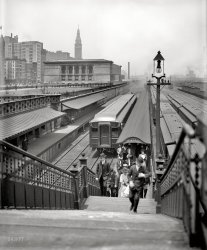
- Miller Time: 1942
- September 1942. "Detroit, Michigan. Milling machine operator at the Allison Motors plant." Acetate ... Posted by Dave - 10/15/2023 - 5:06pm -
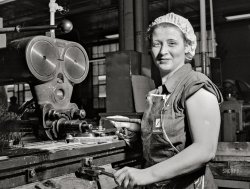
- S.S. Deathtrap: 1910
- ... Electric employees, families and friends across Lake Michigan to Michigan City, Indiana, for a day of fun and fellowship. But the festivities ... Posted by Dave - 09/24/2023 - 9:40pm -
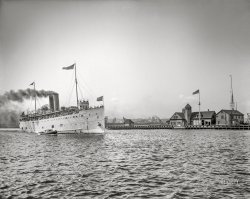
- Scenic Petoskey: 1908
- Circa 1908. "R.R. station at Petoskey, Michigan." Not just a city, Petoskey is also the official state stone. 8x10 ... meets.
Passenger Pigeons This is also the city in Michigan where, when this was taken, it had been 30 years since the last large ... Posted by Dave - 07/29/2012 - 6:12pm -
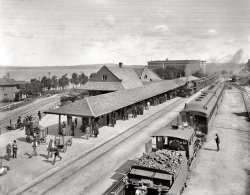
- Fishbowl: 1908
- ... Very prescient design.
Love it!! Re-posted to Michigan in Pictures with links to more historical information on Belle Isle ... Posted by Dave - 04/10/2023 - 4:16pm -
![Fishbowl: 1908 The Belle Isle Park Aquarium in Detroit circa 1908. Its cavernous spaces and glass viewports afforded aquatic life a fascinating peek at the bipedal terrestrial creatures known as homo sapiens. 8x10 inch glass negative, Detroit Publishing Company. View full size.
Hey, what's in that vase?Ewwwww...
Those spittoons just disappeared over the years. And leaving our local museums spit-free except for the occasional cobra or llama. Bet there were some great echo effects bouncing off all the tile work. As a wee bipedaling homo sapien I remember testing out such places with gleeful boy noises. That is one magnificent barrel arch beyond the equally grand dome ceiling.
A Sign of CivilizationI await the return of spittoons to all public buildings.
PixelatedIt's interesting how the brickwork resembles pixels in a digital photo.
[Or a TV. Which was my impression, too -- "These tiles are tiling!" - Dave]
In Swimming ColorThe aquarium today, in all its green glory.
The forward lookBrass expectoration appurtenances notwithstanding (say that fast five times), this photo has a distinct contemporary feel to it - the lighting, natural yet at the same time seeming to be carefully arranged, plus the composition. I can see it on slick paper in an upscale lifestyle-type magazine, advertising fashions, perfumes or other snazzy stuff. Come to think of it, the visual aesthetic, if not the architecture, reminds me of that of the Case Study homes photographs. The pixelation-like effect of the brickwork is also eerily arresting.
League of Extraordinary Museum-GoersWow, the first thing I thought was "steam-punk." Those brass railings and the radiator and the projecting stands for the aquariums are all very cool!
Gone, almostThe building is still there on Belle Isle, but the city closed the aquarium last year due to Detroit's disastrous financial situation. Sigh.
--Ray in Henderson, NV
The Shocking TruthI remember the electric eel that would swim around in its tank and periodically light up a neon sign.
Pewabic Tiles Another Detroit treasure with tiles made by Pewabic Pottery, which is still in business.
Really SciFiAfter the "Lady in the Lake," this image is the most striking I have ever seen on Shorpy (and that's saying something!) Thank you Dave!
Wow, wow, wow, wow, wowThis photo is really ... eerie. It just looks so different from modern times that I can hardly believe it ever happened.
And how in the world did they clean the tanks on those ornate stands jutting out into the middle? Is that an optical illusion, or does the round railing keep one from falling down to another story below?
Thank you for posting the modern photo showing the green tile. I never would have guessed the color. I hope Detroit does better this year, and I hope they can keep this place open in the future.
But what did they do with the fish?I visited the aquarium with my first grade class in the spring of 1957, the high point of the school year.
And it was foreign travel from Windsor Ontario. Back then, we only needed notes from our mothers to cross the border!
Life AquaticI've got relatives in Detroit of long standing, but I've never heard of this delight until now.
There are a few more present-day pictures (how dazzling that green tile is!) on the tour here:
http://www.belleisleaquarium.com/aquarium_tour.htm
Yes, thanks KwameThank you Kwame for closing our wonderful aquarium just so you could spend all the money on your criminal activity. What a shame. Recent pictures that I have seen show that the former aquarium is now full of crap and is being used for storage. Nice.
FramesI really like the frames surrounding the wall tanks, presenting the displayed sea-life like works of art. I wonder if the frames were painted gold or silver to look like gilding.
Fate of the fishThe fish were loaned out to various aquariums across the country. Come visit the aquarium again. Friends of Belle Isle Aquarium care for the koi that overwinter in the basement. They are usually there on Saturdays, late morning, caring for the fish. Check out their website, belleisleaquarium.com for more information or to get involved.
The original aquarium frames were constructed from cypress, a wood particularly resistant to damage from moisture, and were gilded. The frames were carved in an egg and dart motif to frame the exhibits as if they were canvases. The frames were removed during the 1955 renovation and replaced with stainless steel.
The lovely tiles are green glass. They were not made by Pewabic pottery ... a common misconception.
Eero SaarinenI too thought it was a modern building. Very prescient design.
Love it!!Re-posted to Michigan in Pictures with links to more historical information on Belle Isle Aquarium!
(The Gallery, Detroit Photos, DPC, Education, Schools)](https://www.shorpy.com/files/images/4a22191u.thumbnail.jpg)
- Motown Rising: 1918
- ... but which was fairly promptly re-named The University of Michigan. Originally chartered in Detroit in 1817, moved to Ann Arbor in 1837. ... Posted by Dave - 08/02/2012 - 5:23pm -
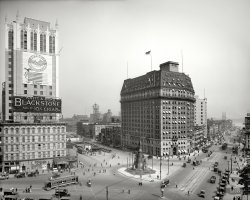
- Size Matters: 1942
- September 1942. "Detroit, Michigan. Learner at the Allison Motors plant. Dimensional finishing." Photo by ... Posted by Dave - 10/14/2023 - 11:17am -
![Size Matters: 1942 September 1942. "Detroit, Michigan. Learner at the Allison Motors plant. Dimensional finishing." Photo by Arthur Rothstein for the Office of War Information. View full size.
The work of an Old MasterThe last two Rothstein pictures remind me of what a fine craft photography used to be. He's doing a routine assignment for the War Dept and turns out a couple masterpieces.
[This (and the other photo) are among seven from this assignment marked "Killed," meaning they were found for whatever reason to be unsuitable for publication. Credit for how they look here goes in part to Photoshop. (And me?!) Below, an image contrasting the edited photo with the original unprocessed scan. - Dave]
Learner needs to learnHow to wear a particle mask. At least when there is a photographer around.
[If he's not grinding, he doesn't need the visor or the mask. Using a micrometer doesn't require any protective gear. - Dave]
That shirtIt is obviously a work shirt and will not be worn to church on Sunday or anywhere dressy. Still, it is ironed and there is a crisp crease going down the sleeve. 1942 was indeed a different age than today.
(The Gallery, Arthur Rothstein, Detroit Photos, Factories, WW2)](https://www.shorpy.com/files/images/SHORPY-8d08001u.thumbnail.jpg)
- Whitefish Bay: 1904
- ... and the song by Gordon Lightfoot refer to Whitefish Bay, Michigan, not Ontario. That said, its still a great song!
Ribs Look at ... the feeling of a Winslow Homer painting.
Whitefish Bay Michigan/Ontario From my knowledge Whitefish Bay is found at the east end of ... Posted by Dave - 06/03/2020 - 2:31pm -
![Whitefish Bay: 1904 1904. "Off for a fishing trip. Whitefish Bay, Ontario." 8x10 inch dry plate glass negative, Detroit Photographic Company. View full size.
Masculine felicityEverything in this photo screams manliness from the hats, to the pipes, to the fishing gear, to those field boots that I want really badly.
Timeless ClassicThe fishing vessel seen here appears to be an example of -- or at least a close approximation of -- the ubiquitous 19th-century Whitehall pulling boats once commonly seen in taxi or delivery service in every North American or English harbor. Still offered today by numerous specialty builders in various lengths, Whitehalls have never been surpassed in terms of combining seaworthiness, speed, dryness, and fine manners in all conditions. They are simply a joy to row.
Who owns this boat? I think the man pushing the boat is the owner of this boat. He is also a married man according to the ring on his left hand. His partner must be single {no ring) and is too relaxed for this to be his boat. He does not seem too concerned about this boat being launched from these rough rocks.
LL BeanAt first, I thought this was a painting. It looks for all the world like the cover to an LL Bean catalog.
Whitefish Bay The Edmund Fitzgerald almost made it there back in '75.
"The searchers all say they'd have made Whitefish Bay
If they'd put fifteen more miles behind 'er"
Wrong Whitefish BayIn response to WM Dyer, the Edmund Fitzgerald and the song by Gordon Lightfoot refer to Whitefish Bay, Michigan, not Ontario. That said, its still a great song!
RibsLook at the rib count. Built like an LL Bean canoe before Fiberglas.
That backgroundis exactly what the famous Canadian artist Tom Thompson would paint. And he may have.
Is that you, Homer?Has all the feeling of a Winslow Homer painting.
Whitefish Bay Michigan/OntarioFrom my knowledge Whitefish Bay is found at the east end of Lake Superior, and borders both Ontario and Michigan.
LJD56, are you saying this in a different location in Ontario? I did find a small hamlet on Google Maps near Lake of the Woods, on a Reserve by that name.
Here is a link to what I have always known as Whitefish Bay.
https://goo.gl/maps/C66DXrgsLq8Nhoau9
MissinaibiI think this might be Whitefish Bay on Missinaibi Lake in Ontario ...
[Detroit Photographic's other 1904 views of Whitefish Bay were taken from Mount Arabella and include McGregor Bay. So this particular Whitefish Bay is in the northern reaches of Lake Huron. - Dave]
(The Gallery, Boats & Bridges, DPC)](https://www.shorpy.com/files/images/SHORPY-4a12064a1.thumbnail.jpg)
- Woodward at Witherell: 1907
- Detroit, Michigan, circa 1907. "Woodward Avenue at Witherell Street, looking south." ... house address numbers on a strip of leather). In 1910, Michigan finally began issuing plates.
Pianos One thing's for sure. If ... Posted by Dave - 08/28/2023 - 10:31am -
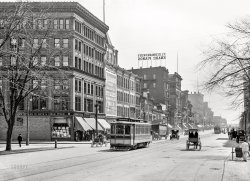
- In the Ice: 1905
- ... and was christened November 1904. It was built for the Michigan Central RR and intended to connect Detroit with Windsor, Ontario. The ... Posted by Dave - 08/05/2012 - 4:28pm -
![In the Ice: 1905 The Detroit River circa 1905. "Transfer steamer Detroit in the ice." Previously seen here under construction. 8x10 inch glass negative. View full size.
Great moment!The sense of man over the elements is huge in this photo! I'm betting that pilot house up top was one COLD spot to work!
ThanksOne two levels: It is getting to be true summer, so that ice looks wonderful; and, secondly, now we can see how that previous shot just hinted at the overall vessel proportions. Again, thanks.
Buffalo-Pitts Steam TractorsThe two on the deck are super interesting. Photos of this particular brand of tractor are really scarce.
[Click below to enlarge! - Dave]
Just don't Google "Detroit Steamer" The first thing that comes up isn't about this Ship.
Deere JohnFabulous tractors shown here. How about finding some more for us, Dave? I would love to add to my collection of locomotives and steamboats with some tractors.
Fantastic image!The Detroit was the second ship built by the Great Lakes Engineering Works, and was christened November 1904. It was built for the Michigan Central RR and intended to connect Detroit with Windsor, Ontario. The Detroit was sold to the Wabash RR in 1912, and again changed hands in 1969 when the Wabash merged with Norfolk Southern. By 1970 it had been converted to barge service. In 1994, NS stopped ferry operations and the Detroit was sold for scrap.
The hull of very similar, though larger car ferry (the Manitowoc?) was moored in a slip near Ecorse MI, at the Nicholson Terminal and Docks, a few years back. US Steel is adjacent there, and it may have been scrapped.
Great image! Notice the aft ship's wheel. Not a happy helmsman who had to stand back there.
(The Gallery, Boats & Bridges, DPC, Railroads)](https://www.shorpy.com/files/images/4a15739a1.thumbnail.jpg)
- Detroit on the Ways: 1904
- November 1904. Ecorse, Michigan. "Great Lake Engineering Works. Steamer Detroit , Michigan Central Transfer, before the launch." The giant railcar ferry seen ... November 1904 and entered service 13 January 1905 for the Michigan Central Railroad Company, operating between Detroit and Windsor, ... Posted by Dave - 08/02/2013 - 10:20am -
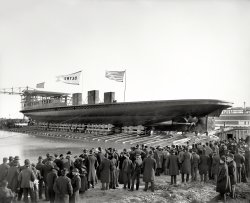
- Headquarters: 1942
- August 1942. "Detroit, Michigan. Children." Acetate negative by John Vachon for the U.S. Foreign ... full size.
Collector extraordinaire The owner of Michigan Stamp and Coin Company was William Frederick Fratcher. He also ... Posted by Dave - 08/12/2023 - 2:52pm -
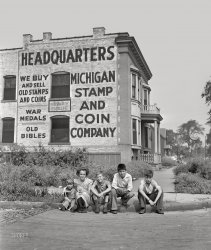
- Down to the River: 1910
- Detroit, Michigan, circa 1910. "Approach to the Detroit River tunnel." 8x10 inch dry ... isn't much left except for the tunnels. The Enormous Michigan Central Station rests in decay roughly 180 degrees from this position ... Posted by Dave - 08/15/2012 - 3:54pm -
![Down to the River: 1910 Detroit, Michigan, circa 1910. "Approach to the Detroit River tunnel." 8x10 inch dry plate glass negative, Detroit Publishing Company. View full size.
Oh, thanks Dave.I’m glad you cleared that up: I thought there had been a terrible gondola accident.
After 101 YearsThere isn't much left except for the tunnels. The Enormous Michigan Central Station rests in decay roughly 180 degrees from this position on the map.
View Larger Map
DebrisWhy is there so much debris on the lower tracks?
[The tunnel is still under construction. - Dave]
Spillage"Clean up in aisle, errr, track 1".
And the final result isa postcard with the same viewpoint, that photo likely shot around the same time. The junk on the right-of-way was taken out by retouching, rather obviously, I think. That's typical. But there are other things changed so you can play "Spot the difference" -- click to enlarge.
Refreshing!I'll have a Coal n' Coke and make it snappy, I've got a train to catch!
The Michigan Central tunnel is still in existence (and was previewed in yesterday's "Infrastructure: 1910" post featuring the nearby Michigan Central Station), but its future is in question.
IHCInteresting to see the International Harvester building on the right. IH was headquartered out of Illinois, so this must have been a branch.
In the BeginningI think what always impresses and at times saddens me greatly when looking at some of these photos is the immediacy of the moment that is captured and the newness of the public works some of which continue to exist albeit 100 years of grime, rust, spalled concrete, etc.I have always wondered at times looking at the remnants of civilizations past what the original monuments looked like,in the Shorpy photos we can go back at least 100 years to actually see the moment of birth of some of these often ignored public works.
100 years of wearHere's a winter view, looks even worse but it's a littler closer.
http://www.detroitfunk.com/?p=1393
(The Gallery, Detroit Photos, DPC, Railroads)](https://www.shorpy.com/files/images/4a23701a.thumbnail.jpg)
- Early Freddy: 1902
- Circa 1902. "Entrance, Sanitarium Park, Alma, Michigan." Baseball boys, a nursemaid, Mr. F. Krueger, an electric (?) ... Posted by Dave - 08/30/2023 - 10:30am -
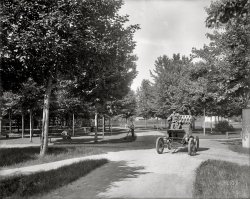
- Victorian Vines: 1910
- Detroit circa 1910. "Bagley Homestead -- Michigan Conservatory of Music." Former abode of Michigan Governor John Judson ...
Catalogue of the Michigan Conservatory of Music , Detroit, school year 1907-1908.
Long Gone The John Judson Bagley Home ... Posted by Dave - 03/25/2014 - 12:34pm -
![Victorian Vines: 1910 Detroit circa 1910. "Bagley Homestead -- Michigan Conservatory of Music." Former abode of Michigan Governor John Judson Bagley (1832-1881). 8x10 inch dry plate glass negative, Detroit Publishing Company. View full size.
Just an empty lot now.But at least there is this!
Catalogue of the Michigan Conservatory of Music, Detroit, school year 1907-1908.
Long GoneThe John Judson Bagley Home was demolished to make way for the construction of the Statler Hotel 101 years ago (July 2, 1913). "Former Gov. John Judson Bagley acquired the site in 1863 and built his home, which remained in the family until it was sold to Arthur H. Fleming in 1907. It was Fleming who sold the property to Ellsworth M. Statler’s chain of hotels."
The Statler, which opened Feb. 6, 1915, "had private baths (a first for a Detroit hotel), in-room telephones and cold running water in every room. It also was the first hotel in the nation with air-conditioning in all public areas. Such features were nearly unheard of at the time it was built. The Statler also had a complete medical department on the top floor."
The Statler became a Hilton property in 1954 (as did all Statler properties that year). Hilton ceased operation of the hotel in 1974 and it was then ran (for about a year) as the Detroit Heritage Hotel. Abandoned in 1975, the structure rotted away (very sadly, like much of Detroit) for 30 years, finally being demolished in 2005. The site remains an empty lot, but with a current investor proposal (Jan, 2014) to build a "Boutique Hotel Development" on the property it may finally be utilized again.
Quoted text credit to:
HistoricDetroit.org
WiredIn addition to the distribution ring off to the right of the conservatory, I see on the rooftop to the left, a swingset looking A-frame structure with insulators to hold the wires.
[Very good. Now explain to us the sideways weather vane. - Dave]
A windy day?
Another exampleAllowing vines to grow on your house isn't good. The vines grab onto the mortar causing it to need tuck-pointing sooner. The vines are also a natural path for insects to get into the house.
With apologies to Bob DylanYou don't need a weathervane to tell which way the wind blows.
(The Gallery, Detroit Photos, DPC, Education, Schools, Music)](https://www.shorpy.com/files/images/SHORPY_4a22858a.thumbnail.jpg)
- Eureka Vacuum: 1912
- Detroit, Michigan, circa 1912. "Woodward Avenue." A shopper's paradise. Meet you in an ... Posted by Dave - 08/04/2021 - 3:43pm -
![Eureka Vacuum: 1912 Detroit, Michigan, circa 1912. "Woodward Avenue." A shopper's paradise. Meet you in an hour at Cinnabon. Detroit Publishing glass negative. View full size.
View from Grand Circus ParkDetroit renumbered all of their street addresses in 1920. Therefore, the old 260 address on the left indicates that this photo was actually taken from Grand Circus Park where Park Ave. (foreground) intersects with Woodward.
View Larger Map
View Larger Map
I am disappointed!!Just when I was in the mood for some Chop Suey and not a place in sight.
Player Pianos, Fifth FloorHope they had a good elevator!
Woodward buildings still standI think the current street view above is a little off. I think this picture was taken from a spot just south of Grand Circus park between where the Whitney Building and Broderick Tower are now. Most of the buildings on the right including Grinnell Brothers still stand. Also the block of buildings on the left south of the Pontchartrain Hotel are still standing.
Re What were they thinking?"When this is 'View full size' we're all be dead."
PianosI counted 6 piano stores not 3.
Grinnell BrothersGrinnell Brothers (sign on right side of street) was a Detroit area institution all the way into the 1980's, when the entire chain went out of business. They had stores in every area mall and not only sold pianos, but other musical instruments, lessons, records, sheet music, pianos rolls, everything to do with music. Wonderful stores, they just couldn't keep up with the times.
What were they thinking?I love pictures like this! This is a frozen second in the lives of all these people. Where were they all going? What were they thinking about? Who was worried, or excited, and about what? Who had just gotten good news, or bad news? Who was going to work, or to do something fun? Who was pregnant, or had new a child, or grandchild?
I also wonder what was playing at the theater. I assume it was live theater, primarily, although there were quite a few short films, and the production of feature-length films was only a few years away.
If I had my choiceI have to agree with user "tterrace", I'd much rather walk down the 1910 version of Woodward than today's, oh if just for a day. What sights to behold.
What happenedGrowing up in Detroit and remembering my mother taking me downtown on the streetcar and shopping at Hudsons, Kerns, and Crowleys and then for being a good kid she took me across the street to Kresge's downstairs and bought me a waffle sandwich which I will never forget. I often hear the phrase "you can't go back" but I miss and loved the way the city was.
Mouse Furs, yuck!Oh wait, it's Mau's Furs.
Never mind.
What Could It Be?I wonder what the three objects are on the street to the left and in front of the second streetcar. No one is near them.
[Newspaper bundles, thrown off the streetcar for pickup by Woodward Avenue newsies, would be my guess. - Dave]
Prettier?I won't get in to the prettier/not prettier debate, but based on Anon. Tipster's Google Street View links, the adjectives that occur to me are more along the lines of : 1910: alive, vibrant, visually diverse, inviting; 2011: sterile, lifeless, visually monotonous, inhospitable.
Hats anyone?As far as I can tell, with the exception of one small boy, everyone is wearing a hat. Ah, those were the days.
Lots of piano storesI counted three different piano shops on this block, Bush & Lane, Manufacturer's and Melville Clark. Was this a sort of "piano district" at the time, or were pianos just ubiquitous enough in parlours of the day that several dealers on a single block was nothing unusual?
[Player pianos were, I think, something like the plasma TVs of their day. - Dave]
"Spirit of Detroit"The buildings at the left have been replaced by the statue "Spirit of Detroit" and Coleman Young Municipal Center. There's an automatic "people mover" tram running almost directly above where the camera was. This part of Detroit is quite a bit prettier now than it was a century ago.
View Larger Map
View Larger Map
Urgent need to tinkleIs there anyplace on this street that sells pianos??
Of course it's DetroitMore cars here than any other 1910 picture we have seen.
One thing, I think I'm pretty knowledgeable about antique cars, but does anyone know what the heck that round tank on the rear of the car at center right is? Has me puzzled.
[Something steamy, perhaps. Condenser? Reservoir? - Dave]
Are You Properly Attired? The boy about to board the trolley seems to be, although the ring around his shoulders could also be a part of whatever he's dragging behind him. A lamp maybe? Hard to tell - I run out of pixels before I can enlarge/enhance it enough. Still, it looks like a bicycle tire to me. Perhaps other Shorpists will have better data.
Bush & Lane Piano Co.on the left had their main manufacturing facility in Holland, MI. They went out of business in 1930, victims of the Depression as were many other piano manufacturers.
Right RulesLooks like all the cars of the time were right hand drive. Anyone know when we decided to change?
[Gradually. - Dave]
Majestic TheatreThe Majestic Theatre opened in April 1915 per its website, so I wonder it that dates this post to 1915.
[Detroit had several Majestic Theatres over the years. The Majestic in this photo opened in 1908 at 231 Woodward. - Dave]
Piano StoresOK, I count at least six piano stores! And at least three fur stores.
More piano storesI'm counting possibly seven piano stores--Bush and Lane Pianos, Manufacturers Piano Co, Cable Piano Co, Tarrand Pianos, Grinnel Bros Pianos, Melville Clark Pianos, and another just to the upper right of the Grinnel Sign. I'm surprised that there isn't a Wurlitzer sign somewhere in this. I'm also seeing a Victor Records. Pianos were all the rage for years--before everyone had radios and tv. People learned to play for entertainment for themselves and others.
(The Gallery, Detroit Photos, DPC, Stores & Markets, Streetcars)](https://www.shorpy.com/files/images/4a24401a.thumbnail.jpg)
- Detroit: 1910
- Detroit, Michigan, circa 1910. "Hotel Pontchartrain and Campus Martius." Frequent ... Posted by Dave - 12/02/2022 - 1:05pm -
![Detroit: 1910 Detroit, Michigan, circa 1910. "Hotel Pontchartrain and Campus Martius." Frequent photographic subjects of the Detroit Publishing Co. View full size.
Big BrotherIt must have been a challenge trying to operate the tiny Hotel Metropole in the shadow of the giant Pontchartrain.
And what a testament to the brand power of Coca-Cola. Ninety-five years later, that logo is so modern that it sticks out like a photobomb.
Times They Are A-ChangingIf you were to have taken this picture 5 years before the horses would outnumber the cars.
Who's Selling What??Love to know what "Misfit" is advertising.
["Misfit" seems to have been the retail category for what we would today call clothing seconds, or maybe something more like Big & Tall. There's another Misfit sign shown here, in New York, and here, in St. Louis. - Dave]
WildlifeI love the stag and deer statues. Those things are huge!
Misfits explainedBelieve it or not, people would have their pictures taken and not show up for the prints. Photogs would sell the orphan or - Misfits - pictures to recoup their losses.
The main market for these Misfts, were immigrant bachelors who wanted to send pictures of their sweeties back home, but they either didn't have sweeties, or they didn't have enough to have their pictures taken.
Hence, an immigrant bachelor who wanted to impress the family back in County Cork, or Berlin, would finger through the Misfit bins and pick out athe girl of their dreams.
[That's a colorful explanation but, as noted below, these are clothing stores. This particular Misfit was the haberdashery owned by Sol Berman (you can see BERMAN on the awning) at 120 Woodward Avenue in Detroit. Below, another Misfit Clothing Parlor in New York. - Dave]
Migrating Wildlife The "stag and deer" statue is actually of elk. It's one of several temporary monuments that were erected in Detroit for the 1910 national convention of the Benevolent and Protective Order of Elks (BPOE), which was hosted by the Pontchartrain Hotel.
(The Gallery, Detroit Photos, DPC, Streetcars)](https://www.shorpy.com/files/images/4a25864a.thumbnail.jpg)
- The Accident: 1906
- November 12, 1906. "Accident at Michigan Central R.R. depot, Detroit." 8x10 inch dry plate glass negative, ... Central conductor.
Detroit, Mich. Nov. 12. -- One man was killed and a number of others injured, ...
Executive Summary Detroit, Nov 12 -- A switch engine ran wild in the Michigan Central yards this ... Posted by Dave - 06/09/2018 - 5:18pm -
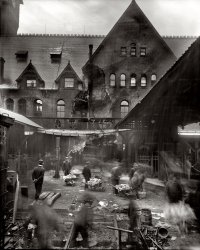
- Young Guns: 1942
- August 1942. "Detroit, Michigan. Boys in the Polish district." Acetate negative by John Vachon for the ... Posted by Dave - 08/16/2023 - 2:02pm -

- Detroit: 1910
- Detroit, Michigan, circa 1910. "City Hall and Campus Martius." 8x10 inch dry plate glass ... Posted by Dave - 08/08/2012 - 3:10pm -
![Detroit: 1910 Detroit, Michigan, circa 1910. "City Hall and Campus Martius." 8x10 inch dry plate glass negative, Detroit Publishing Company. View full size.
+101If the Soldiers and Sailors Monument hasn't moved in the past 101 years, this is the street view of basically the same area today. Looks like Detroit has leveled all the structures that were standing in 1910.
[It has moved twice over the years. To the left of the Google Street View below is the 100-year-old Dime Bank. - Dave]
View Larger Map
Fantastic!This photo is absolutely perfect! There are men, cars, advertising, women, children, horses and so much more. I love it. What a great window into the past.
The Food To Tie To
Annual Report of the Commissioner of Patents for the Year 1911.
Patentees of Designs, Trade-marks, Labels and Prints.
…
Kellogg Toasted Corn Flake Co., Battle Creek, Mich. "The Food To Tie To" (For Prepared Cereal Foods.) No. 2,877; Nov 7; Gaz. vol. 172; p. 258.
…
Apparently, "The Food To Tie To" failed as an ad campaign — it does feel awkward to pronounce. Prior to this post, a Google search of this Kellogg's slogan yielded only two results: both google-book scans of a 1912 government publication of patent listings. Follow the Google search of this slogan to witness the steady accumulation of search-engine results as a multitude of blog/web-sites scrape and automatically re-post content from Shorpy.
P.S. Undoubtedly this black-and-white image of the Kellogg's "The Food To Tie To" sign on the Campus Martius fails to capture the contrast and readability that the full-color signage would have presented. It is difficult to read the slogan and one must look closely to see the cowboy and his lasso. Any Shorpy photo-colorationists willing to lend their skills to offer historical palette schemes which might have attracted the eye of a 1910 breakfast-cereal consumer?
View TodayHas anyone got a modern view of this site? Given Detroit's decline, it would be interesting to see it from this angle.
[See above. The notion that downtown Detroit is some sort of decaying urban wasteland is a mistaken one. - Dave]
Parallel ParkingIn 1964 I managed to fail the parallel parking portion of my driver's test while driving a relatively small 1962 Dodge Dart with power steering and automatic transmission.
It appears the taxi guy is trying to park that 3 ton beast without the benefit of power steering or automatic trans. He's a better man than I.
[Circa 1910 Hudson Model 20 touring car. At around 1,800 pounds, it weighed less than a ton. - Dave]
If onlyIf only time travel were possible. To me, that era was the most serene. Discounting any wars, epidemics or such. I would go.
The BoothInformation? Tickets of some kind? It looks too small to be a news or food vendor booth.
[It's a kiosk of the kind used for posting bulletins, news, weather etc. - Dave]
The Kellogg signThe original Kellogg Toasted Corn Flakes box was not colorful by today's standards, being dark green and red lettering on a beige background, but with those three banks of lights focused on it, I am sure it stood out on the sign. On close inspection it appears that the rope lasso also might have had its own string of lights just above it. As far as what the lighting on the cowboy might have been, it is anyone's guess. To get an idea of the original box (and tin) colors, just Google "Kellogg's Toasted Corn Flakes" images.
[The rope itself is a string of lights. This sign probably used hundreds of bulbs. - Dave]
(The Gallery, Cars, Trucks, Buses, Detroit Photos, DPC, Streetcars)](https://www.shorpy.com/files/images/4a25139a.thumbnail.jpg)
- Traffic Ahead: 1901
- ... which was originally built for the Engineering Society of Detroit, but is now owned by the University of Michigan and largely leased to Wayne State University.
Previously on ... Posted by Dave - 01/29/2023 - 3:35pm -
![Traffic Ahead: 1901 Detroit circa 1901. "Woodward Avenue and Farnsworth Street." The future Motor City on the cusp of the Motor Century. 8x10 inch glass negative. View full size.
Re: Pole ClimbingThe town here in Texas where I grew up still had the metal climbing steps on poles in the late 70s, but by then the bottom steps had been raised about 7 or 8 feet off the sidewalk, probably to keep adventurous kids from climbing the poles.
I always wondered what the world looked like from the top of a pole.
Detroit Institute of Artsand the main library, across the street. The only two things on Woodward Avenue that don't make me think I was born 75 years too late.
bjzielinski's Street View is in front of the Maccabees Building, original (radio) home of The Lone Ranger.
Actually, Cater-Corner From the LibraryThis view is looking southeast at the corner of Woodward and Farnsworth. Farnsworth does not extend west of Woodward (the street to the west of Woodward is named Putnam). The future (and current) site of Main Library is thus out of view to the far right of the picture. Similarly, the site of the Detroit Institute of Arts, to the northeast of this corner, is out of view to the far left.
The location shown is now the site of the Horace Rackham Education Memorial Building (opened in 1941), which was originally built for the Engineering Society of Detroit, but is now owned by the University of Michigan and largely leased to Wayne State University.
Previously on ShorpyLooking up Farnsworth in this Kodachrome from 1942. One of the photos that helped get me addicted to Shorpy way back when.
Interesting poles for sureThree quick Shorpy questions:
1. The street lamp almost in the middle of the photo appears to have a pulley and rope, extending down the pole to the street. Is this light now electrified, where its predecessor perhaps was oil-fired, requiring raising and lowering the lamp twice daily for lighting and extinguishing, plus re-filling the oil?
2. The other poles which seem to be handling electricity, also basically in the center of the photo, appear to be metal. since they're honey-combed in the middle. I would have thought wood was the preferred pole material. Were these man-made (and fairly stylish) back in 1901?
3. Finally, I hope someone shows us that intersection today. Bet it looks incredibly different now.
About those polesPower poles could be and WERE made from a number of different materials, although wood was the preferred medium. In western New York, many power poles and street lamp poles from this time period were made from reinforced concrete, which wasn't surprising because the County Engineer "happened" to own a batching plant. But like them or not, they were still usable until the late 1950s and early 60s. The metal poles that replaced them only lasted and twenty to twenty-five years.
Pole ClimbingSome telephone poles still had the climbing steps in them when I grew up on the 50s.
Since then they've discovered climbing spurs.
LibraryIt looks like this photo is looking north along Woodward. If so, then the main branch of the Detroit Public Library was built in the open area to the right of the second house.
Designed by Cass Gilbert, the library was started with a $750,000 gift by Andrew Carnegie. He offered the money in 1901, but the city didn't get around to accepting until 1910. Some things don't change.
Eventually, the houses were replaced by the front lawn of the library, probably when it expanded in the '60s.
Current viewView Larger Map
PolesMark, those are arc lights, which were high maintenance compared to later incandescent and todays bulbs. Note the transformer on the pole just below the attachment of the bracket arm, the wires dropping down to it from the crossarm, and the low voltage wires hanging in a catenary shaped arc to the lamp fixture. Arc lights were much brighter and lower maintenance than oil lights. The carbon rods had to be replaced regularly, but nowhere near the daily schedule required of oil or gas lamps.
Two methods were common for the way to lower the lamps. Often, the metal arm which reached out over the center of the street or intersection would be pivoted to the pole, and the winch would lower the whole arm through an arc to a level where the worker could perform his duties. In this picture, lowering the metal cantilever could interfere with the trolley wires, so the arm was mounted rigidly and the lamp was lowered straight down to service it.
The metal poles in the background were for the trolley line. Wooden poles were used in the early days, round metal pipe poles with a bell shaped cap were very common, and metal lattice as seen in this picture were used to a lesser extent.
Those poles and the pulleyThe metal poles are for the trolley car company's wires. More prosperous lines used metal because it lasted almost forever. Philadelphia still uses some that were erected at the start of electric service in the mid 1890s, although they have received new paint, and some have rusted to death from the inside.
The light on a rope might be an arc light, whose carbons need periodic adjustment. The trolley workers can climb on top of one of their cars to get to their wires in the middle of the street, while the electric company's men climb poles, in this case to disconnect wires so the light can be brought within reach of an adjuster on the ground.
That locationThat location would be Woodward Avenue and Farnsworth Street.
[Incorrect. - Dave]
(The Gallery, Detroit Photos, DPC, Streetcars)](https://www.shorpy.com/files/images/SHORPY_4a03646a.thumbnail.jpg)
- Comic-Con: 1942
- August 9, 1942. "Interlochen, Michigan. National music camp where 300 or more young musicians study symphonic ... Posted by Dave - 08/24/2023 - 8:44pm -

- Livingstone Channel: 1910
- ... Erie Made Easier — The Opening Celebrated.
Detroit, Mich., Oct. 19. — With the booming of guns and blowing of ... Carrier's Association.
The City of Detroit, Michigan, Vol. IV, 1922.
For a number of years Mr. [William] ... Posted by Dave - 08/21/2012 - 11:18am -
![Livingstone Channel: 1910 "Livingstone Channel, looking east." Construction of the navigation channel along the Detroit River circa 1910. 8x10 dry plate glass negative. View full size.
$10 Million Ditch
New York Times, Oct 20, 1912
New Channel at Detroit
Navigation into Lake Erie Made Easier — The Opening Celebrated.
Detroit, Mich., Oct. 19. — With the booming of guns and blowing of steamship whistles, the Livingston channel, from the lower Detroit River into Lake Erie, was formally opened to commerce to-day and a fleet of fifteen vessels passed through it and on to lower lake port destinations.
The new channel is constructed at a cost of $10,000,000 and will relieve congestion in the dangerous Lime Kiln crossing, where rocky banks and a swift current have heretofore troubled navigators and deleayed traffic. The ceremonies to-day were under the auspices of the Lake Carrier's Association.
The City of Detroit, Michigan, Vol. IV, 1922.
For a number of years Mr. [William] Livingstone advocated the construction of an independent waterway for down-bound vessels in the lower Detroit river and spent much time interesting the government engineers in the work and prevailing upon congress to supply the necessary funds for the development of the channel. In 1906 congress made an appropriation for surveys and in 1907 appropriated funds for the work and authorized it to be known as the "Livingstone Channel" in recognition of the many services rendered by Mr. Livingstone. Work was begun in the spring of 1908 and completed in the fall of 1912. The channel was opened to commerce October 19, 1912, with imposing ceremonies. This channel ranks with the important engineering feats of the age.
Mr. Livingstone's progeny and legacyWilliam Livingstone has previously appeared with his children here in the "Classic Rockers: 1900" photo. According to this source, he served as president of the Lake Carriers Association from 1909 until his death in July, 1925.
The channel which was named in his honor is located here in the lower Detroit River on the west side of Bois Blanc (Bob-Lo) Island. It is used by downbound vessels while upbound vessels use the Amherstburg Channel east of the Island, except during the slow winter shipping season when the Livingstone Channel is used in both directions as a traffic-controlled, one way channel.
Detroit River Bypass The $10M appropriated for this much needed "Ditch" was only a scratch on the surface. This feat of engineering was to cost many more millions before it was completed to the satisfaction of the shipping industry in the 1930's. The channel itself was cut in the "dry," meaning the river was dammed in the area of excavation and pumped out. It was completed in sections. The photo shown is looking northward, I believe, and one can see the power houses used for supplying electricity to the huge travelling bucket towers in the background. The pile of rock to the right in the photo was left there and today it is referred to as Spider Mountain by the locals. The specifications for the initial cut was: 12 miles long 22 feet deep and 300 feet wide (min.) On completion in 1912 it was already outgrown by the increase in size of the newer vessels and plans were set underway for enlarging the system even more.
(The Gallery, Boats & Bridges, DPC, Railroads)](https://www.shorpy.com/files/images/4a19561a.thumbnail.jpg)
- Primitive Ferry: 1907
- ... than a steam engine. But that's just my assumption.
Michigan Several years ago, I was in Charlevoix, Michigan. They had (may still have) a ferry there that could carry one or two ... Posted by Dave - 08/21/2012 - 7:50pm -

- Hello, Goodbye: 1942
- August 1942. "Detroit, Michigan. Waiting room at Greyhound bus depot." Medium format acetate negative ... Posted by Dave - 08/13/2023 - 3:33pm -

- Tubular Lanterns: 1905
- ... States, 1910.
Tinplates and Terne Plates.
Michigan
Buhl Stamping Company, Detroit. Tinning plant erected in 1888; ...
BUHL STAMPING COMPANY,
Cor. Third and Larned Sts., Detroit, Mich.
Sufficient capacity to make every Milk Can used in the ... Posted by Dave - 08/08/2011 - 10:18am -
![Tubular Lanterns: 1905 Detroit circa 1905. "Buhl Stamping Co., 3rd Ave. and Larned." Note the "Cheese Factory" milk cans illustrated between the windows, and the arc-lamp "moonlight tower" to the right. 8x10 glass negative, Detroit Publishing Co. View full size.
Rough Road?What is the road surface made of? Is it brick that just has dirt and perhaps "wintertime" stuff on it? Or is it actually a dirt road. I've seen this in other pictures and have wondered.
[Brick pavers are probably somewhere under there. - Dave]
Relatively new buildingArchitecturally, I'd guess that's a fairly new building. It has pretty simple/plain lines, and more importantly it's probably using iron or steel window headers (rather than brick arches as was used in older buildings.) Compare to the building on the left, where there are those arches above the windows. (Still, I'm not sure if those arches are decorative or structural.)
What's the building to the right? It's much fancier, and could be a post office, courthouse or railroad station. I'd guess the latter, just because this plant needs rail service presumably going into the back of the structure (raw materials in, finished milk cans out.)
[That's the Fort Street Union Depot. - Dave]
Rail RoadI have always loved Milk Cans.
CannedAll of the buildings in this picture are long gone. I'm in my early 50s, and am just old enough to remember using the Fort Street depot. The depot was a truly beautiful Richardsonesque red sandstone building with a large blocky clock tower that loomed over Fort Street for over 80 years.
These buildings were replaced by Wayne County Community College, its parking lot, and the Lodge Freeway. Although their domination over the milk can business has long since faded away, the Buhl family remains one of the Detroit area's most prominent families, with one of downtown Detroit's most beautiful skyscrapers named for them.
Buhl Tinning Plant
Iron and Steel Works of the United States, 1910.
Tinplates and Terne Plates.
Michigan
Buhl Stamping Company, Detroit. Tinning plant erected in 1888; product, tinplates, all consumed by the company in the manufacture of milk-can stock, tubular lanterns, etc. A galvanizing plant is connected with the works. Fuel, coal. Buys back plates.
The World Almanac & Encyclopedia, 1901,
The Press Publishing Co., NY.
Perfect Milk Cans are essential to profitable dairying. A Milk Can is not perfect unless it can be kept absolutely clean and free from germs and unless it will last five or ten years without repairs.
The highest award at the Paris Exposition of 1900 was granted to the Buhl Cans on these two points, Buhl Cans have the patented "Victor" Can Breast, smooth as glass and free from spinning marks.
Buhl Cans have no crevices within where milk can lodge, and sour, and smell.
Buhl Cans are perfectly tinned and free from blemish of any kind.
Buhl Cans are heavily and smoothly soldered within and without and every can is tested.
Buhl Cans will not break, leak, or rust like common cans.
Buhl Cans are indorsed by the highest dairy authorities for their cleanliness and great durability. They are used by the United States Government and the largest creameries in the country.
They cost a little more than other cans, but will last twice as long without repairs, and are easier to clean.
If these points appeal to you, send for our book of
testimonials "From Mexico to the Top of the Earth,"
and price list.
We caution can buyers against imitation Buhl Cans
offered by some supply houses. Every genuine Buhl
Can bears our labels, and is stamped with the Milk
Can Trademark.
It is a pleasure to answer inquiries in regard to
these goods. Send your order direct to the makers.
BUHL STAMPING COMPANY,
Cor. Third and Larned Sts., Detroit, Mich.
Sufficient capacity to make every Milk Can used in the
United States.
Not to be confused with RR lampsTubular lanterns are characterized by vertical tubes that flank the globe, as shown by the illustration at right. Although one line of railroad lanterns, the Dietz "Vesta", used this design, the vast majority of tubular lanterns were manufactured for general domestic, farm, and industrial purposes. There were many variations on this general style using both the "hot blast" and "cold blast" combustion design. Many different manufacturers, including R.E. Dietz, Embury, and C.T. Ham, produced tubular lanterns, and some production continues to this day for domestic and specialty markets.
Tubular lanterns are frequently misidentified as railroad lanterns.
more info ...
Fort Street DepotAl, your command of the history of Detroit is amazing. One thing I never realized, even though I have looked at both buildings dozens of times, was the similarity between the Fort Street Depot and Old Main (for those unfamiliar - old Central High now part of Wayne State).
I see there is a plug for the Evening News on the side of the building next door too.
(The Gallery, Detroit Photos, DPC, Factories)](https://www.shorpy.com/files/images/4a22000a.thumbnail.jpg)
- Drs. K & K: 1910
- Detroit, 1910. "Michigan Avenue at Griswold Street and Lafayette Boulevard." Where Drs. Kennedy ... a leather base.
Do yourself a favor If you get to Detroit, find this corner for some delicious Detroit Coney Island hotdogs . ... Posted by Dave - 03/24/2023 - 1:19pm -

- The Drugstore: 1913
- ... sponges
Bath sponges
Automobile sponges
Manistee, Michigan I have no idea where this was taken, but if you are ever in Manistee, Michigan, there is a historical society museum on Water Street that looks very ... Posted by Dave - 07/30/2012 - 2:14pm -
![The Drugstore: 1913 1913. No location given. "G.W. Armstrong drugstore." Seidlitz Powders only 25 cents. 8x10 glass negative, Detroit Publishing Company. View full size.
You get all wrapped up in the cigarsand completely neglect the righthand side, where Peter's, Red Rapt and Romance brands of chocolate, among others, are being offered along with Beech-Nut peppermints.
And back on the left: can one imagine anyone going to the trouble now of re-sharpening safety razor blades? Can one even imagine it then?
Those were the daysMy late uncle would have known what toilet cream was. He once told me he used toilet water but he stopped after the seat came down and hit him on the back of the head.
Salida, Colorado?I was curious to find out where this was located. On another site, I found this picture was labeled as a gift from the Colorado Historical Society. There was a G. W. Armstrong who owned a large drugstore in Salida, CO - though it looks like he sold it in 1910.
[Every one of the 25,000+ Detroit Publishing glass negatives in the Library of Congress archive is a gift from the Colorado Historical Society. This drugstore was most likely in Detroit or New York (or maybe Boston). - Dave]
Toilet CreamWhat is toilet cream? Preparation H?
Commode to JoyWow, so much to look at in this shot. This is going to waste several hours of my time this afternoon.
I see at the upper left that Gibson's Toilet Cream is only a quarter (although it may be an exorbitant 75 cents).
I'll bet it smelled unique in thereThis reminds me of a drug store I used to go in as a kid. They also sold photography equipment and some cosmetics. Really had a neat aroma about it. Hard to explain, but if there's any other old farts out there, they will remember what an old time drug store smelled like.
Chocolates!Scrolling around on my little laptop screen, I came to the stacks of wrapped packages, first, and wondered what was in them. When I scrolled a bit farther, I saw the answer. What I wouldn't give for a chance to taste those chocolates!
I wonder if the cup holders on the left were for sale, or were for holding coffee and tea in some kind of disposable cup. I love pictures like this!
[The holders are for soda fountain customers. - Dave]
Continental In Europe, once you get out of the big cities, you can still find drugstores that don't look unlike this one (you have to ask for things behind the counter and/or try to figure out what the HECK THAT IS behind the counter!) In the USA however, this kind of lovely, quaint drugstore is pretty much gone, sad but true.
What a treasure!My head almost exploded when I saw this! Fantastic snapshot full of history -- and 75 cent toilet cream!
Toilet creamGibson's Toilet Cream sounds interesting. What the heck is that for?
[For the complexion, a la toilet soap. - Dave]
Vinol, a Nutritive Tonic.Now we know what it is.
Two things I would hate to do:Take inventory of the place or be the sap who had to build those coffee displays on top.
I can see the poor guy with a handlebar mustache, garters on his sleeves, a green visor, and button down shoes trying to accomplish those tasks.
Noble TobaccoPrince Albert had his can; Peter the Great his box.
Mahogany & MarbleI'm always impressed by the incredible craftsmanship and the intent of permanence in the construction of these old stores. That paneling is fit for Rockefeller's study and the mosaic floor is a work of art. If a modern drug store was built with the same level of skill and materials today, we couldn't afford to shop there due to the overhead!
Gibsons Toilet CreamFor dry, chapped Porcelain.
I took one apartAs a young kid, my neighbor was a pharmacist. He bought out an old time drugstore in South Baltimore after the elderly gent passed away. His old store looked much like this one, although it hadn't been open in a year or more.
My neighbor gave several of us young fellows a little spending money one summer to help him take this old store apart. My druggist neighbor purchased any drug stocks and equipment, including soda fountain items.
We spent the better part of the day hauling things out to the truck. Some of the more valuable items had already been taken.
That old store on Cross Street must have looked like this in its heyday.
Pardon meBut do you have Peter the Great in a Box? well you better let him out!
Sometimes a cigar is just a cigarRuby Star Cigars
Look Like 15 cents - Smoke Like 10 cents
Our Price 7 cents - 4 for 25 cents
The last bit comes out to 6.25 cents each, but it still looks like 15 cents and smokes like 10 cents! And that was a lot of money, back then. It was expensive to be a cigar smoking waif, back in the day.
Western Union ClockThe clock over the doorway is a Western Union Self Winding pendulum clock. It used one of the old telephone batteries to re-wind itself after it had run down a certain amount. Western Union sent out a time pulse from the central office every hour which had been synchronized with U.S. Naval Observatory time at noontime every day. If the clock in a customers office was more than ten seconds off it would not reset automatically on the hour and a tech would have to go fix it. Every main W.U. office in metropolitan areas had a Master clock which was synched with Naval time. These master clocks set sub-master clocks in smaller towns and the sub-masters sent the time pulse to the customers premises.
Perhaps BostonA case could be made that the store may have been here. No G.W. Armstrong appears in various directories of druggists around the time of the shot, but the G.W. Armstrong Dining Room and News Company was a strong presence in the New England railroad scene. The company ran the restaurant and the newsstand at the Boston station at the time, and a druggist trade journal describes how the company opened, and later expanded, a drug store in the same complex.
From a 1908 ABC Pathfinder Railway Guide:
A note from the "Boston Briefs" section of the trade publication Journal of the N.A.R.D (National Association of Retail Druggists):
VertigoIf you have never experienced vertigo, now is your chance. Focus on the bottom of that floor. Now use your browser button to push that image quickly up to the ceiling. Whew! Now down. Now UP. Whew. Now down. Now UP. Whew. Now down. Now UP. Whew.
Did Last In Last Out (LILO) rule in this store, or who got stuck with the old stock. I'm thinking a parent sent in a kid to get a can of Prince Albert and the clerk went up the ladder and pulled out the FILO can for him. I'm thinking this because when I was 8 my aunt sent me to the grocery for a loaf a bread. The clerk gave me a day-old with a torn wrapper. My aunt and I were back in the store before the clerk could say "got rid o' that one, boss".
I want to be the bookkeeper for this place. I direct and you stock.
Great photo, Shorpy. Thanks.
Re: VertigoI did that trick and felt the sensation you described. I didn't get vertigo bad enough to keep me from finding a dime or quarter on the tile floor left of center about seven tiles up from the bottom. Love all drug store pictures, especially earlier than the 50's.
SpongesI like the three grades of sponges available in the lower cabinet right in the middle of the picture:
Velvet sponges
Bath sponges
Automobile sponges
Manistee, MichiganI have no idea where this was taken, but if you are ever in Manistee, Michigan, there is a historical society museum on Water Street that looks very much like this...but with side rooms and an amazing upstairs. The drugstore closed suddenly and the whole thing...including contents...was given to the museum. It is preserved much as it was. Bonus: The most interesting thing is a preserved (through taxidermy) double calf head, yes real, from a two-headed calf born nearby.
http://www.manisteemuseum.org/about_us
(The Gallery, DPC, Stores & Markets)](https://www.shorpy.com/files/images/4a25722a_0.thumbnail.jpg)
- Lake Drive: 1912
- ... Detroit suburbs circa 1912. "Lake Drive -- Grosse Pointe, Michigan." 8x10 inch dry plate glass negative, Detroit Publishing Company. ... until they cross Alter Road.
Porcelain Plates 1912 Michigan license tags had black letters on an orange background, and the plate ... Posted by Dave - 06/17/2023 - 2:13pm -
























